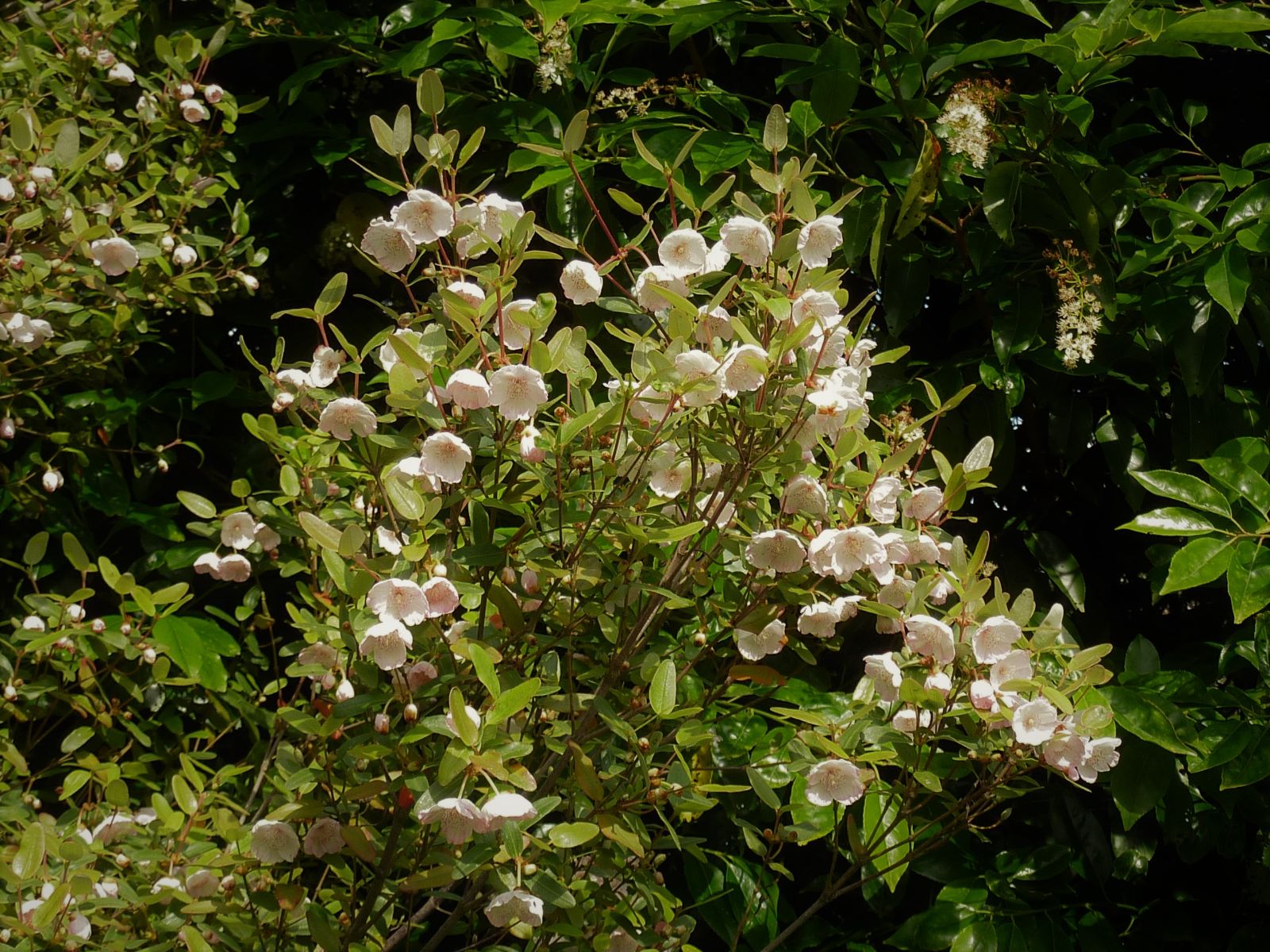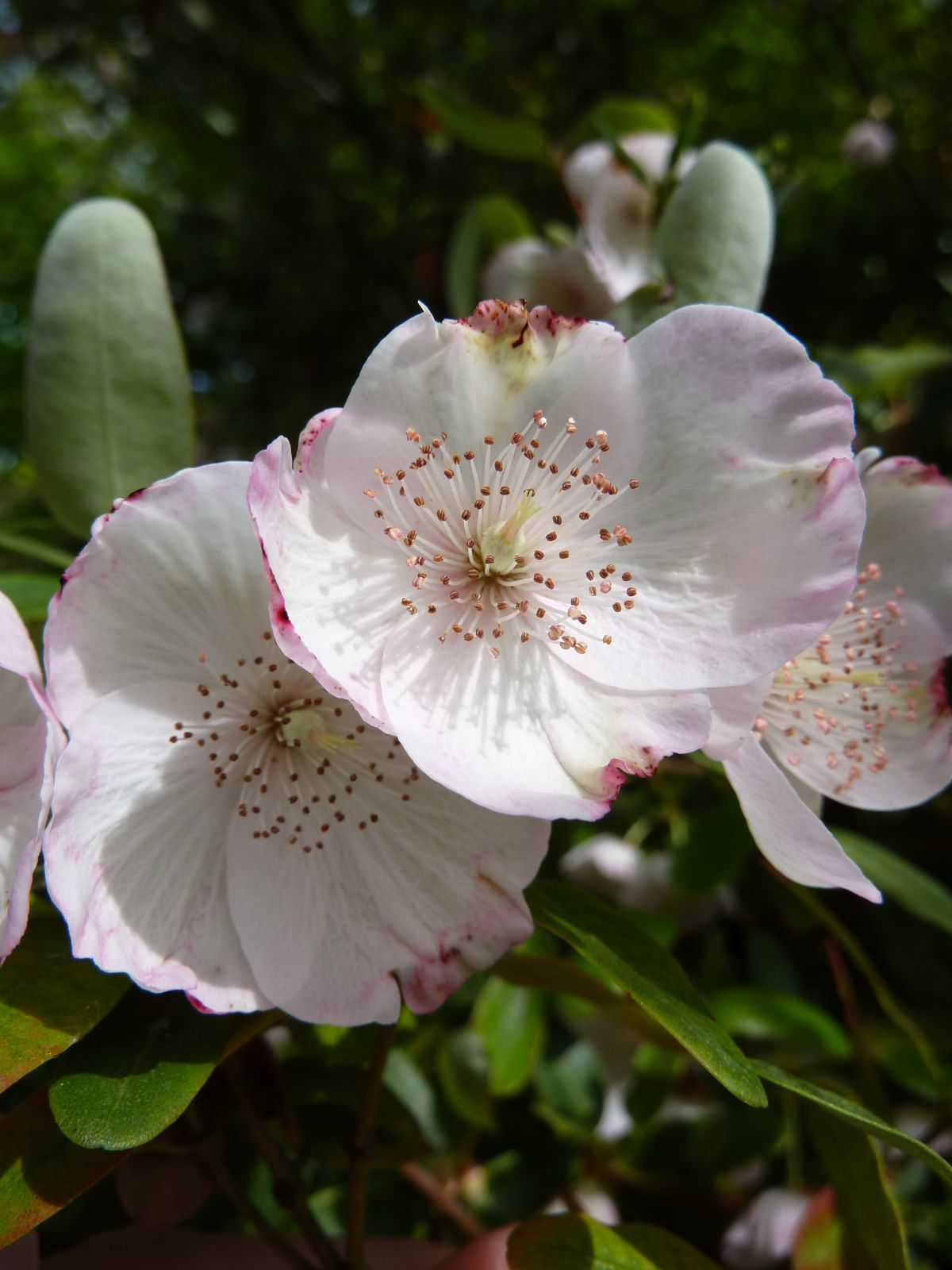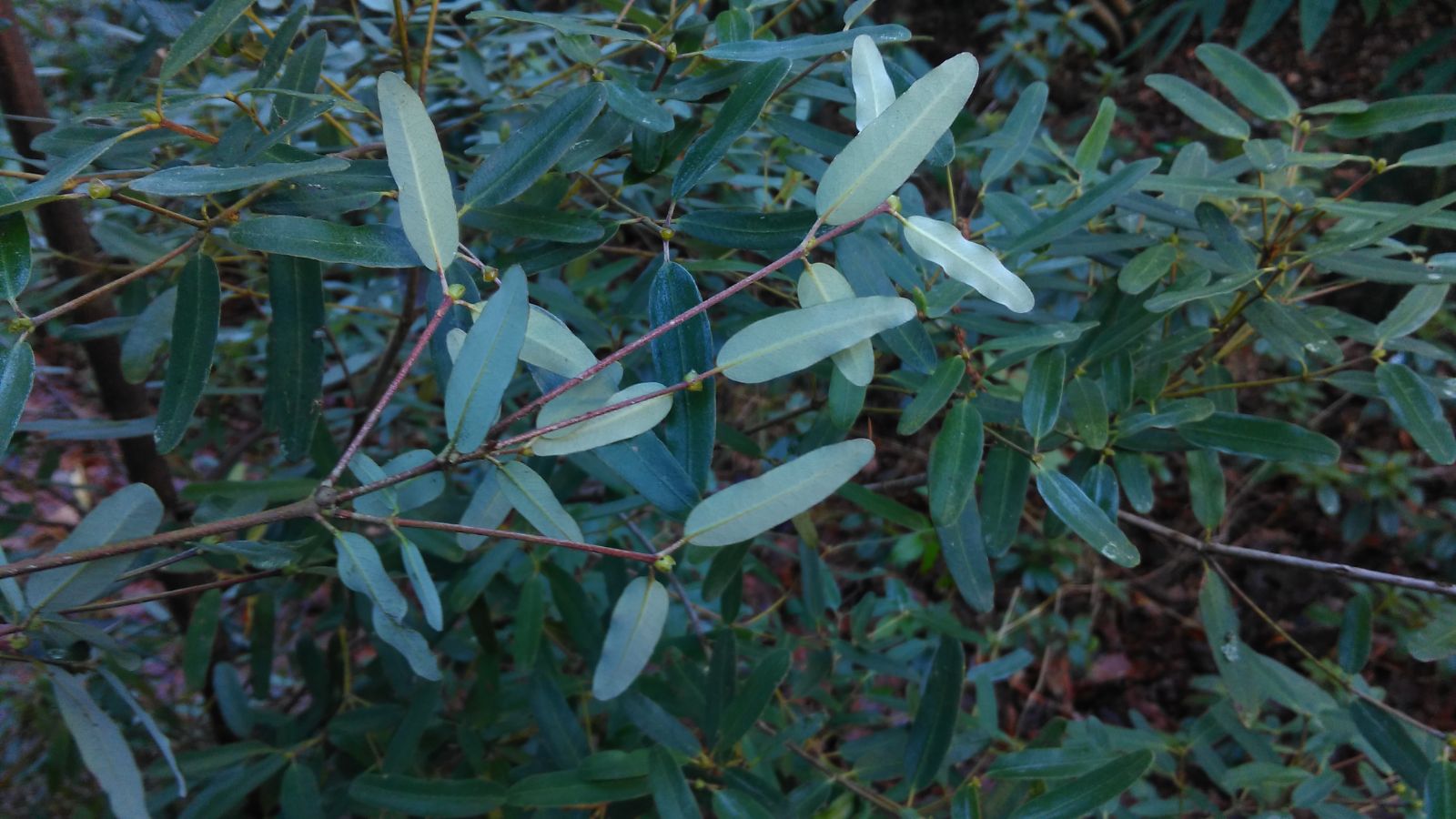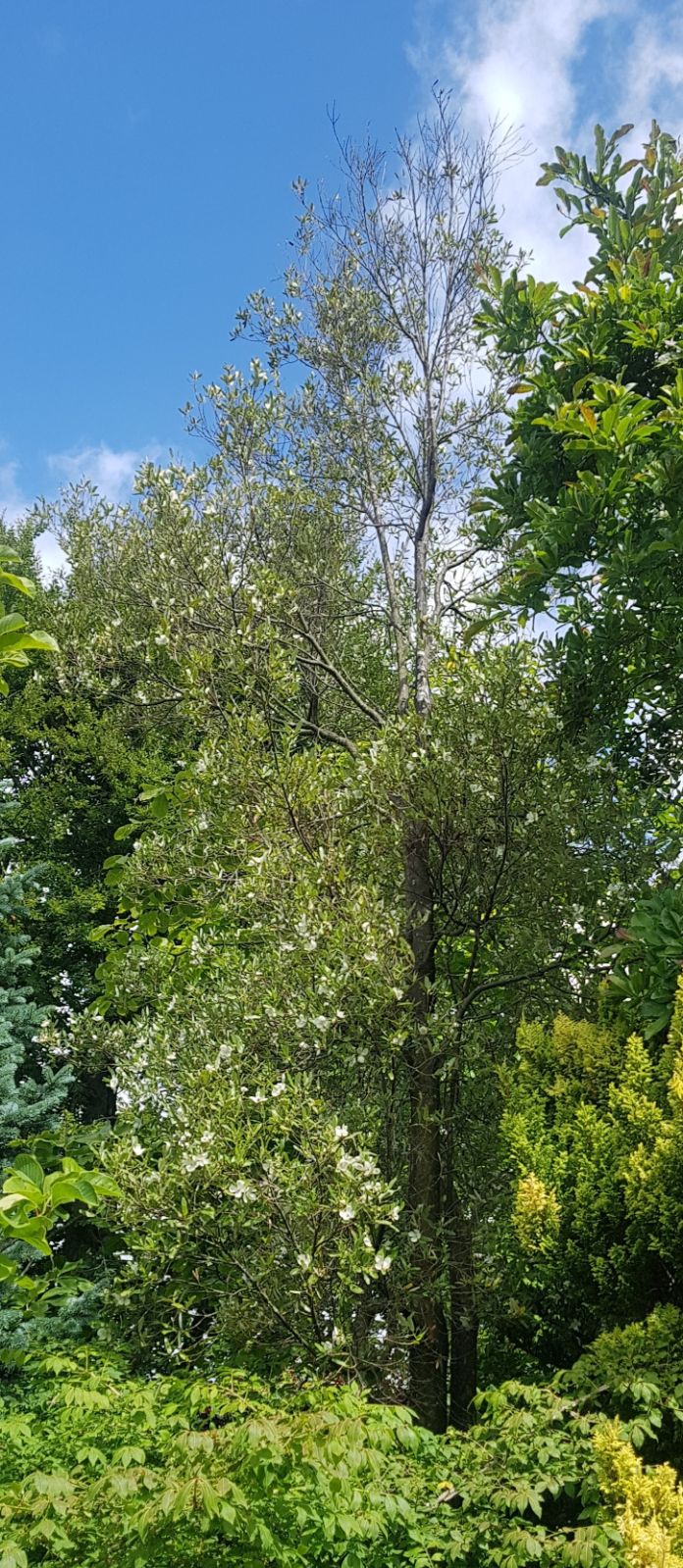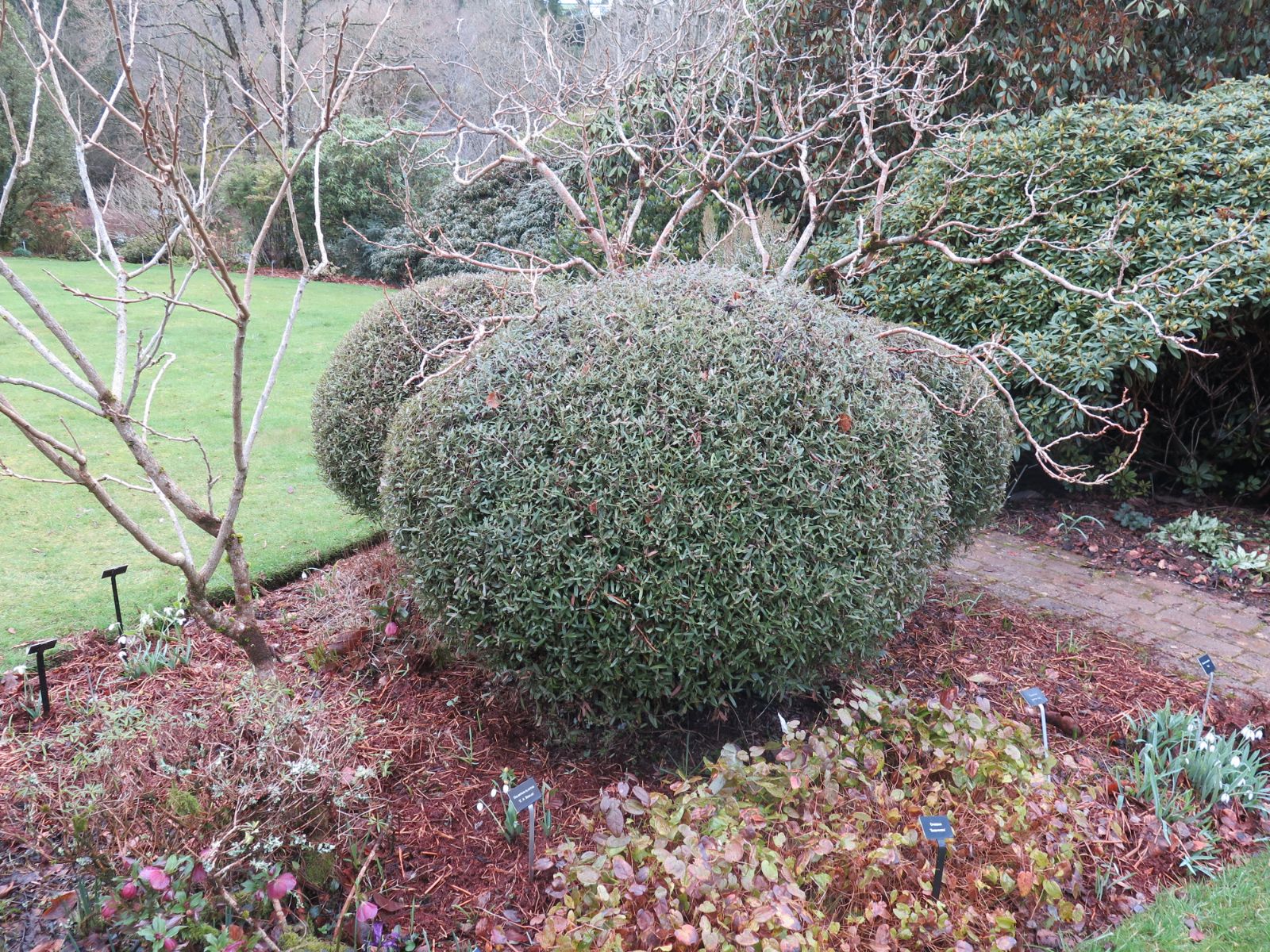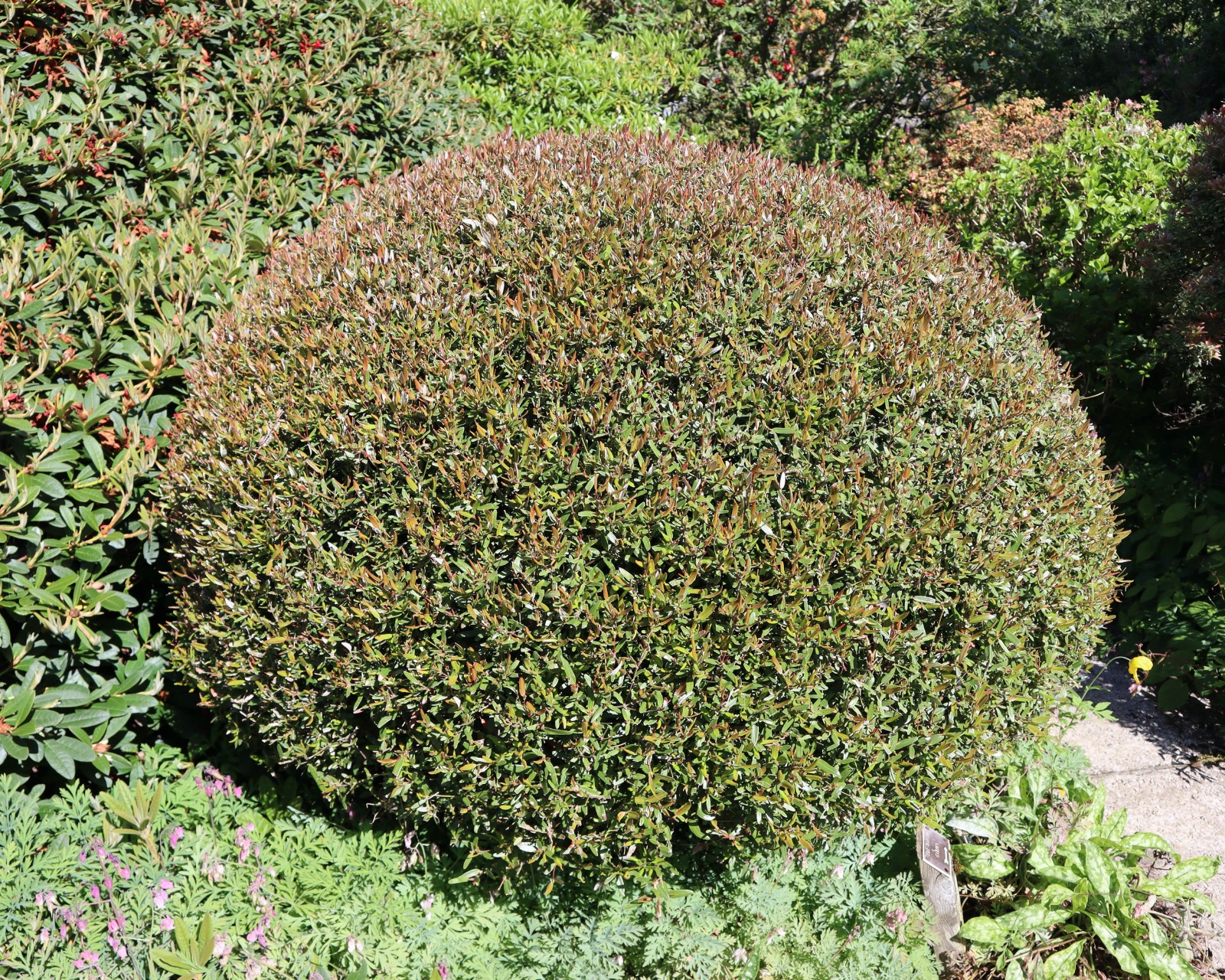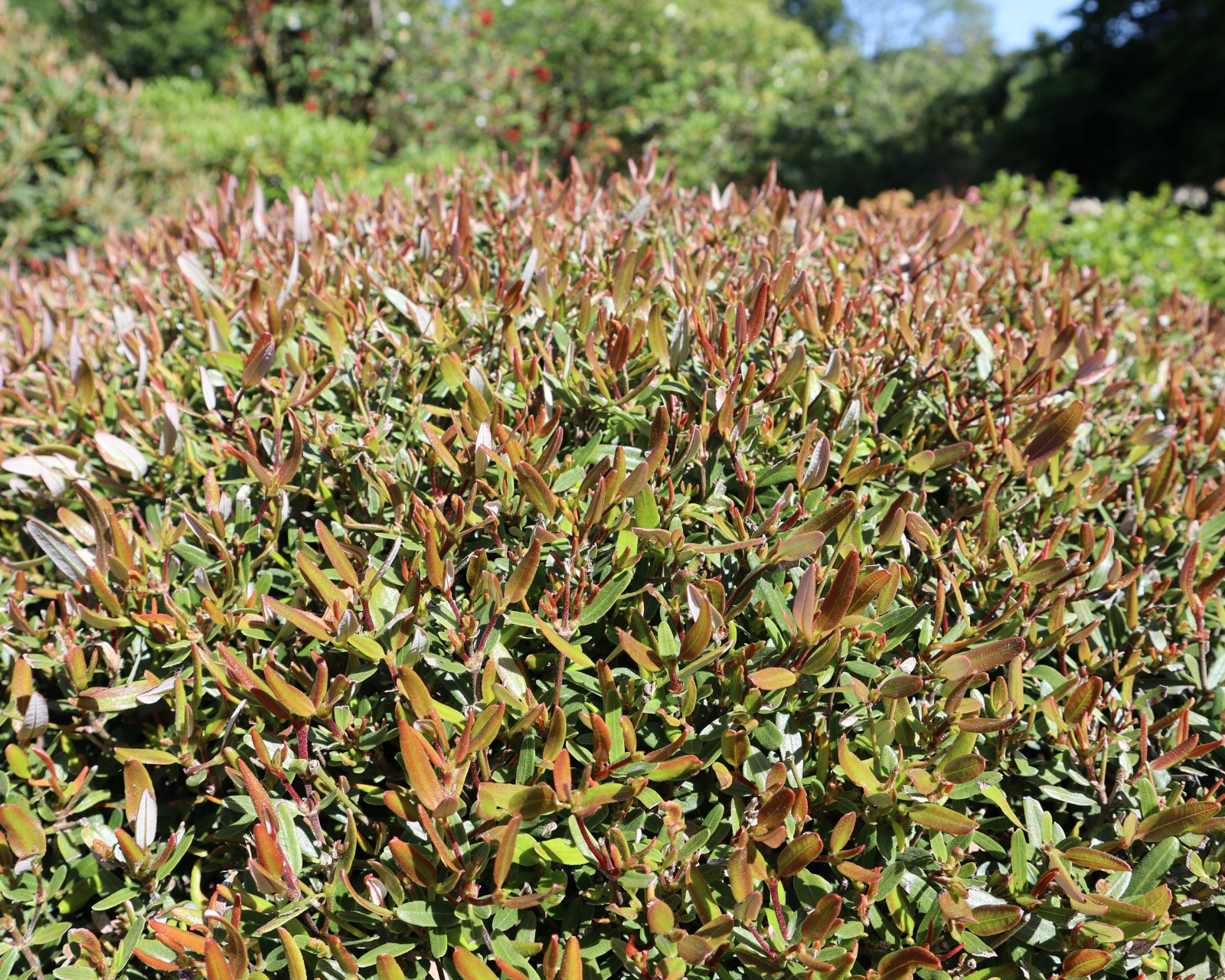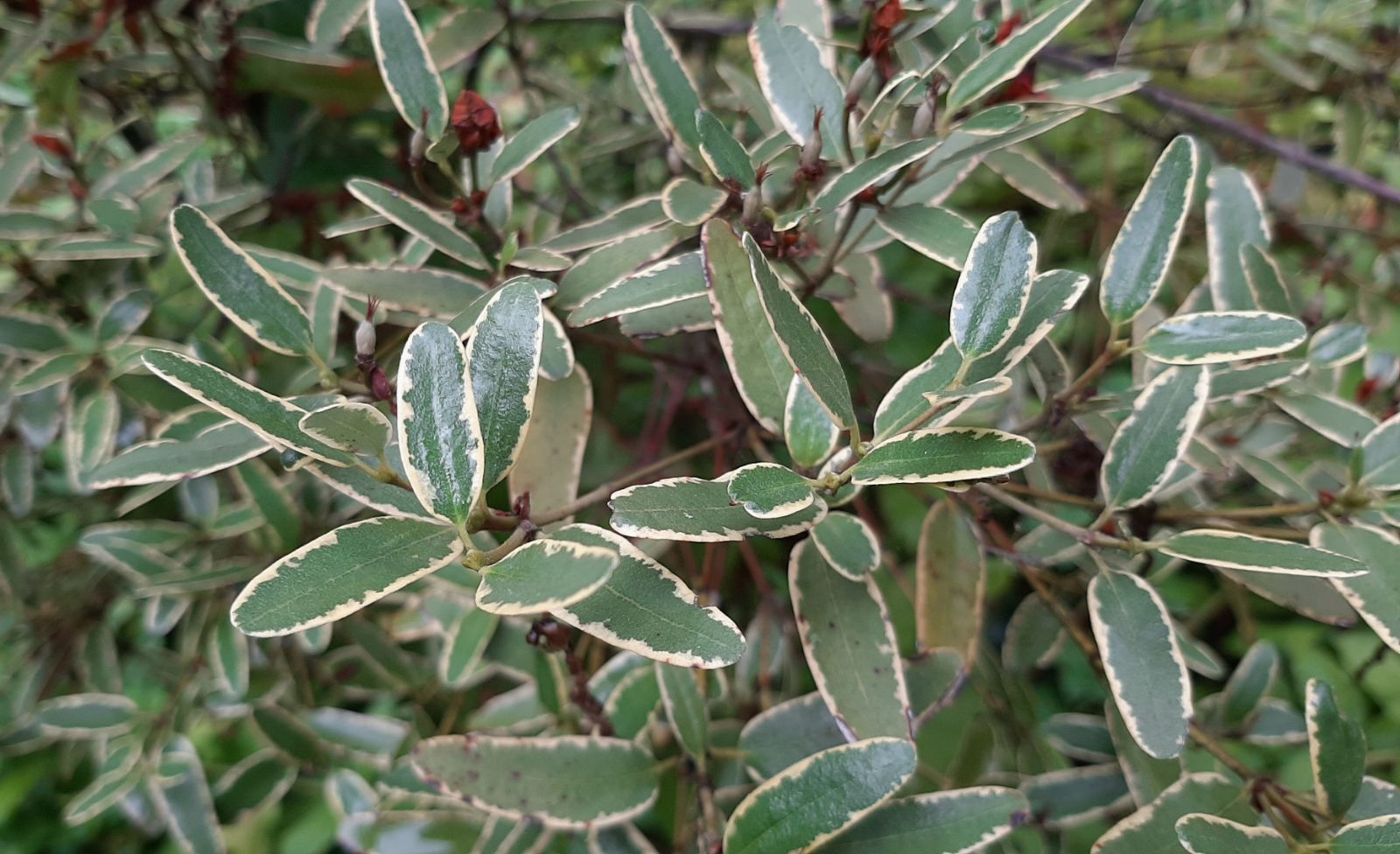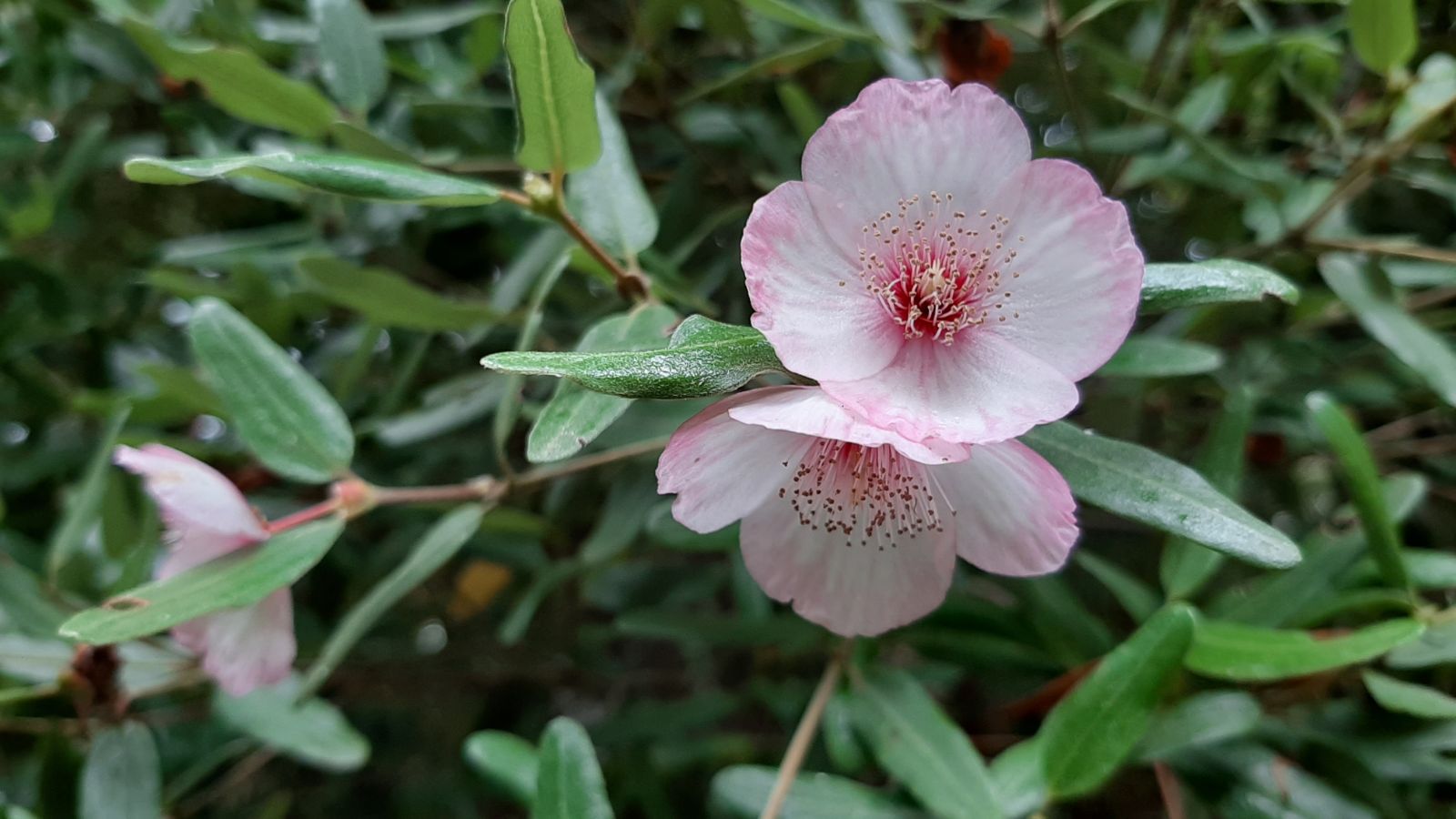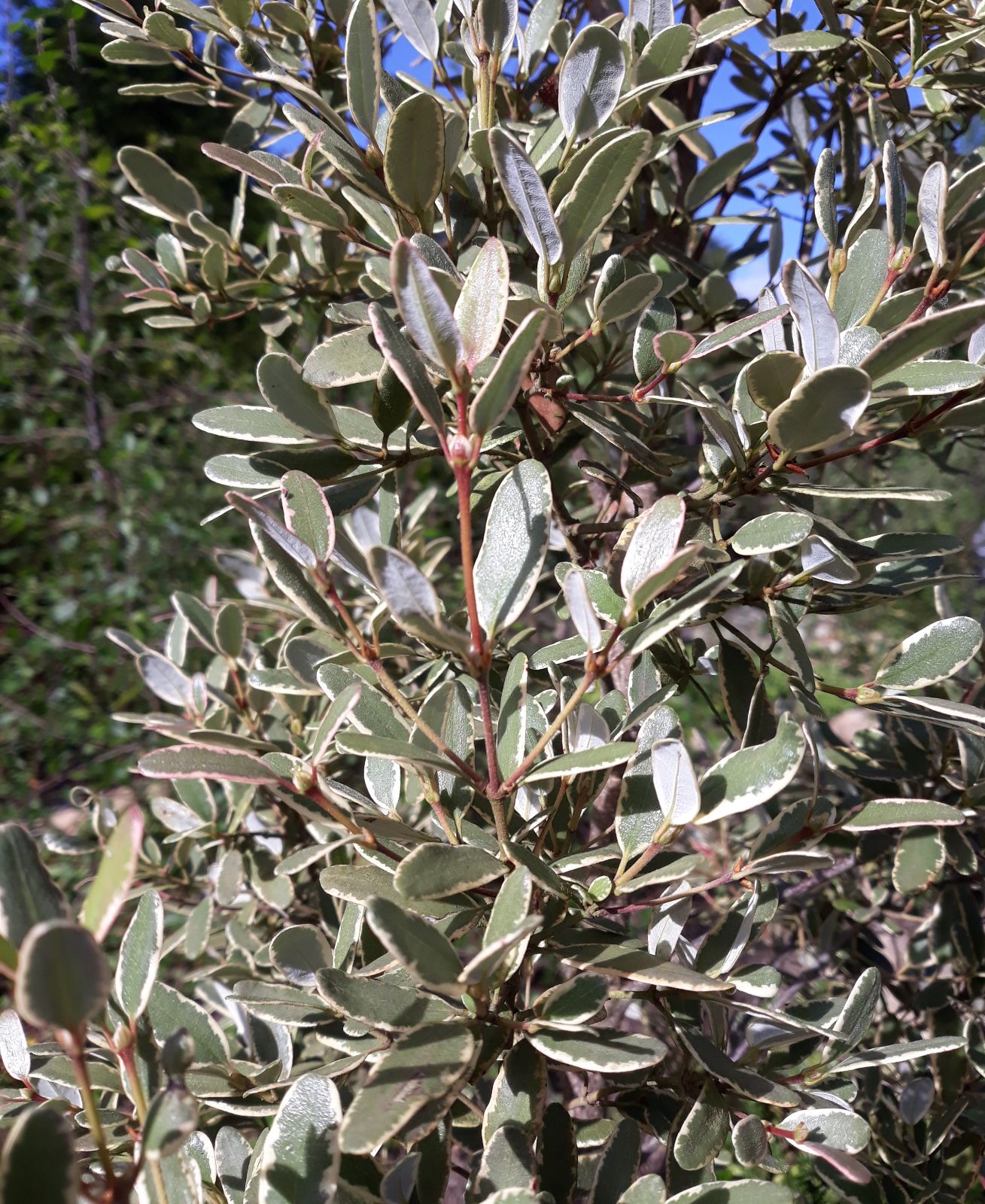Eucryphia lucida
Sponsor
Kindly sponsored by
William & Griselda Kerr
Credits
Tom Christian (2021)
Recommended citation
Christian, T. (2021), 'Eucryphia lucida' from the website Trees and Shrubs Online (treesandshrubsonline.
Infraspecifics
Evergreen tree with a large altitudinal range, giving rise to its natural height being cited in literature as between (2–)10–15(–30) m, obviously reflecting alpine conditions, ‘typical’ mid-elevation conditions, and very particular micro-habitats which might allow exceptionally tall examples to occur. In cultivation it is similarly variable, but perhaps in a condensed range of 5–15 m. Young shoots downy. Buds and young leaves sticky. Leaves leathery, simple, narrowly oblong to elliptic, with a rounded apex, entire margins, sometimes ciliate, glossy dark green above and glaucous beneath, 3.5–7.5 cm long, 1–1.5 cm wide, always at least three times longer than broad, with a short glabrous petiole to 3 mm long. Flowers solitary, 2.5–5 cm across, sweetly scented, with a pendulous, pubescent stalk to 1.5 cm borne from the leaf axils. Flowers subtended by two bracts (four in E. milliganii). Fruit cylindrical, dry, woody, 1.5 cm long × 6 mm wide, pedicel of the fruit 1.5–2.5 times longer than the fruit. (Bausch 1938; Cullen et al. 2011).
Distribution Australia Tasmania
Habitat Temperate rainforests, with associates including Nothofagus cunninghamii, Atherosperma moschatum and Acacia melanoxylon.
USDA Hardiness Zone 7-10
RHS Hardiness Rating H4
Conservation status Not evaluated (NE)
Native to Tasmania, Eucryphia lucida is abundant in temperate rainforests in the west of the State where it enjoys up to 2.5 m of annual rainfall and is common from low elevation to sub-alpine habitats. It is a vigorous, fast growing component of these forests and dense thickets of it can regenerate in recently disturbed areas (Gray 2004). It is sympatric with, and closely related to E. milliganii, which replaces E. lucida at higher elevations (Wallace 2015). The principal differences between them include the size of the flower (2.5–5 cm across in lucida cf. to 1.6 cm across in milliganii); the number of bracts subtending the flower (2 in lucida cf. 4 in milliganii); the leaf apex (rounded in lucida cf. strongly emarginate in milliganii); and the much smaller and more crowded leaves in milliganii (Bausch 1938; Cullen et al. 2011).Where the two meet intermediate forms may be found, often referred to E. × hybrida.
Hillier & Coombes (2002) suggest E. lucida was introduced to Britain in 1820, some 20 years after it was described to science following its discovery by Jacques Labillardière during a voyage to Oceania that had sailed from France in 1791 (Wikipedia 2018). Little is known about the reception E. lucida received on its introduction; it would almost certainly have been treated with great care and afforded space in glasshouse collections until such time as its rate of growth – or an experimental horticulturist – caused it to be tested out of doors where it was later found to thrive at least in milder parts of Britain, including the west coast of Scotland, Cornwall, Devon, and across the island of Ireland.
The species would receive an Award of Merit from the RHS in 1936. By this time it had become well established in cultivation and had already been a co-conspirator in the production of two outstanding hybrids: E. × intermedia (‘Rostrevor’) in Northern Ireland (which also received the Award of Merit in the same year as its E. lucida parent!) and E. × penwithensis (‘Penwith’) in Cornwall. Bean (1981) noted good examples on the terraces at Bodnant and at Nymans, and by 1984 the UK and Ireland champion tree was a 13 m specimen at Glendurgan, Cornwall (since lost). Also in 1936, H.R. Cocker from RBG Kew noted a fine specimen thriving in the garden on Isola Madre in Lake Maggiore, Italy (Cocker 1936).
Although it seems to be widespread in cultivation, in 2018 the publicly accessible database of the Tree Register records only eight examples of the species (excluding its cultivars) across the UK and Ireland, the largest of which is a 17 m tree at Mount Usher, County Wicklow, Ireland. The other notable examples are either in Ireland, the west coast of Scotland, or in Devon and Cornwall, with the exception of a tree at the Royal Botanic Garden Edinburgh, which has reached 9 m height in the sheltered microclimate of the sunken terrace garden behind the temperate lands glasshouse (The Tree Register 2018).
E. lucida is a popular ornamental in its native range and in adjacent areas of Australia and its use in gardens has been promoted here for some time, it is also very important to the Tasmanian apiculture industry – over 70% of all the honey produced in Tasmania relies on the nectar of E. lucida (Gray 2004). It is cultivated in New Zealand where, as in the northern hemisphere, it is a popular summer flowering tree and various cultivars are in the horticultural trade, although E. lucida is generally a bit earlier to flower than the other commonly grown species – in the northern hemisphere it can be flowering by the end of June (pers. obs.). It is equally popular on the west coast of North America, from California to southern British Columbia – the Washington Park Arboretum, for example, cultivates both the species and ‘Pink Cloud’ (University of Washington Botanic Gardens 2018) – but as with most members of the genus it seems to be virtually absent from cultivation in eastern North America. The two pink-flowered cultivars, ‘Ballerina’ and ‘Pink Cloud’, have become very popular since their introductions and indeed are capable of growing into singularly beautiful small trees.
E. lucida can be distinguished from the hybrids it has given rise to in the following ways: from E. × intermedia by the markedly more glaucous underside to the leaves in lucida; from E. × penwithensis by the generally smaller leaves and the downy pubescence adpressed to the shoot in lucida cf. larger leaves and dense and spreading hairs in ‘Penwith’; and from E. × hilleri by its simple leaves vs. compound in × hilleri. Only with the naturally occurring hybrid E. × hybrida is separation sometimes difficult (Cullen et al. 2011).
'Ballerina'
This is a selection with flowers toward the larger end of the given size range for the species, to 3 cm across with deep-pink flushed petals, most strongly at the margins, and crimson or red stamens. It was found in the wild in 1986 by Ken Gillanders and entered cultivation c. 1990. (Edwards & Marshall 2019, anbg.gov.au).
It is very similar to ‘Pink Cloud’ and ‘Carousel’. Distinguishing these can be very difficult. See the entry for ‘Pink Cloud’ for further discussion.
'Carousel'
Another pink-flowered form, ‘flowers flushed pale pink with a darker eye and red stamens’ (Edwards & Marshall 2019), ‘larger pink flowers with crimson stamens on an upright bush’ (bmn.co.nz). Internet searches suggest this clone is presently more widely available in Australia and New Zealand than in Europe or North America, though no information about its origin appears to be available, nor is there any suggestion of a means to separate it from the other pink-flowered clones, ‘Ballerina’ and ‘Pink Cloud’.
'Dumpling'
Selected in the UK by Sarah and Julian Sutton from a seedling purchased c. 1991, which grew into a domed shrub. It was later propagated by Mark Fillan and cutting-raised plants were found to maintain the dwarf, compact habit, growing to c. 1 × 1 m or occasionally taller, to 1.6 m, when drawn up by associated planting. It bears the white flowers typical of the species. It was initially introduced by Pan-Global Plants and is now occasionally offered by several UK nurseries (J. Sutton pers. comm. 2020).
'Gilt Edge'
There are several variegated cultivars of E. lucida including ‘Gilt Edge’, ‘Leatherwood Cream’ and ‘Spring Glow’. These all have leaves with cream or creamy-yellow coloured margins and the differences are slight. ‘Gilt Edge’ reportedly has leaves with a pale-gold margin and is apparently further distinguished by flattened flowers, white as in the species, and by having a proportion of trifoliate leaves across the plant (Edwards & Marshall 2019). This latter character is sometime seen on trees of the species when they are growing especially vigorously, such as from a coppiced stool (Gray 2004).
'Leatherwood Cream'
‘Leaves 2.5 cm long, notched at the tip and with a creamy margin’ (Edwards & Marshall 2019). The atypical notched apex and the small leaf size help to distinguish this clone, which is grown for its variegated foliage and typical white flowers.
Interestingly, the Australian Cultivar Registration Authority notes ‘The leaves appear to be intermediate between those of E. lucida and E. milliganii, being of a size found more often in the former but with the indentation of the leaf apex usually found in the latter’ (anbg.gov.au), suggesting it may in fact belong to the naturally occuring hybrid of these two species, E. × hybrida.
'Pink Cloud'
Eucryphia lucida ‘Pink Cloud’ was first found in the wild by Ken Gillanders in 1984, two years before he discovered E. lucida ‘Ballerina’. The parent was a 20 m tall tree and so far this clone has reached 7 m in cultivation in the UK (The Tree Register 2018).
It is, undeniably, very similar to ‘Ballerina’, and few differences of any significance are apparent from the scant reference works that discuss both these selections. The flowers of ‘Pink Cloud’ are described as ‘pale pink at the margins of the petals shading to white, red at the base’ by Edwards & Marshall (2019), while their description for ‘Ballerina’ reads ‘flowers pale pink, 3 cm across with deep pink margins and red stamens’. The descriptions held by the Australian Cultivar Registration Authority suggest ‘Pink Cloud’ has even larger flowers than ‘Ballerina’, and add that ‘Ballerina’ can be distinguished by having crimson stamens (anbg.gov.au).
Given the differences are so subtle, it seems highly likely that plants of these two pink-flowered cultivars will have been confused at various times both in the nursery trade and in gardens. Both are cultivated at The Wynkcoombe Arboretum, Sussex, UK, where they may be seen close together which is useful for comparison. The arboretum’s website states ‘Difficult to tell the two apart but Ballerina is said to have crimson stamens and is perhaps the pinker flower of the two – Pink Cloud should have white stamens’ (the-wynkcoombe-arboretum.org.uk).
More recently, a selection named ‘Carousel’ has entered the trade. Similar to both, it is closer to ‘Ballerina’, though appears to be largely restricted to cultivation in Australia and New Zealand.
'Spring Glow'
Another introduction from Ken Gillanders, who found the parent plant growing next to a road in south east Tasmania. It has cream-variegated leaves very like ‘Leatherwood Cream’, but the young growth in the spring is flushed deep-pink, this gradually fading as the foliage matures. (Edwards & Marshall 2019).

